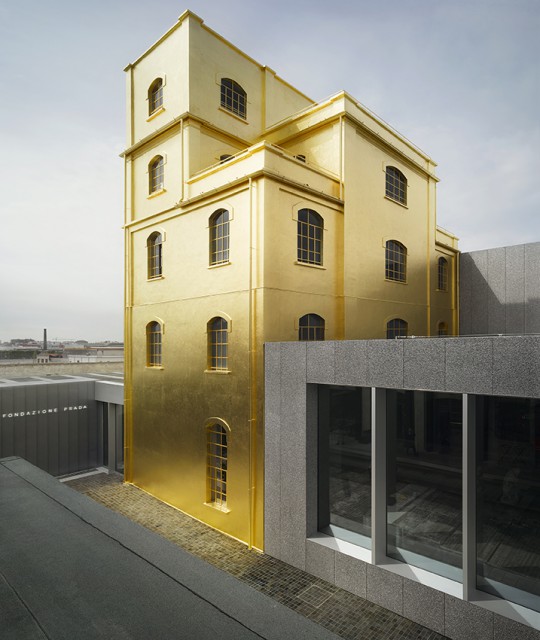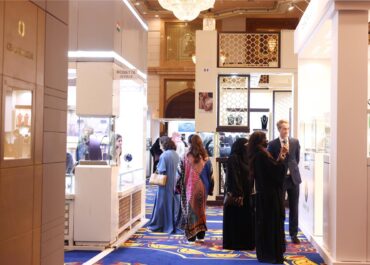Collaborations between the world’s luxury fashion houses and the works of iconic artists are certainly not a new craze. Elsa Schiaparelli (of the eponymous house she founded) started the trend during the 1930s when she began to work with Salvador Dali, Man Ray and a slew of other prominent artists on her couture collections (which were said at the time to make her rival, Coco Chanel, envious of the former’s high brow connections). Indeed, the blurring of distinct creative fields has arguably only accelerated in recent years, championed most prominently by the late great Virgil Abloh who merged the far-flung areas of architecture, contemporary art and fashion in his work.

Fondazione Prada
One of the main reasons for the historic cross-pollination between art and fashion is arguably the symbiotic qualities the two fields offer one another. In simple terms, fashion is mainstream and de jour, whereas art has a gravitas which the fashion industry can only aspire to. Meanwhile, the art industry can gain from the fashion houses’ alluring promise of mainstream exposure. This is perhaps why some of the biggest luxury houses have increasingly decided to branch out and give their name to brick-and-mortar art galleries in some of Europe’s leading cities. The result is some of the most boundary-pushing, breathtaking and innovative collections on offer on the continent. If you need further reason to visit, we’ve put together everything you need to know about Europe’s big four luxury art museums.
Fondation Cartier
The Fondation Cartier pour l’Art Contemporain, commonly known as the Fondation Cartier, was one of the first art museums established by one of the big luxury houses, in 1984. Situated south of the river in Paris, the impressive gallery is certainly worth a visit while in France’s fashion capital. Those who have explored some of the GCC’s modern cultural landmarks might find the building familiar too, as it was designed by renowned architect Jean Nouvel – the mastermind behind the Louvre Abu Dhabi and the National Museum of Qatar. One of the early works by Nouvel, the museum contains many of his signature styles, with its unique glass build blending harmoniously with its surroundings, allowing plenty of natural light to illuminate the artworks. Over the years, the museum has become a beacon for showcasing a diverse range of contemporary artistic expressions, including visual arts, photography, design, and more. It also hosts a variety of temporary exhibitions that feature works by both established and emerging artists from around the world. The main exhibit currently being showcased by the gallery is currently is by Australian artist, Ron Mueck, who is known for his hyper-realistic sculptures of human figures and will be shown until 5th November 2023. According to Charlie Clarke, associate curator of the Ron Mueck exhibition, the latest show aims to reveal the development of Mueck’s work over the last twenty years through “invisible but tangible threads” of connection.
Fondation Louis Vuitton
The second fashion house to establish an art gallery in Paris is Louis Vuitton, which arrived on the French art scene in 2014 with the opening of the Fondation Louis Vuitton in the city’s Bois de Boulogne Park. LVMH, who commissioned the building will only own the property until 2069 due to French planning laws, however, the company has arguably created an architectural masterpiece with the build (the work of architect Frank Gehry) which means that the structure of the Fondation Louis Vuitton is likely to remain long after the lease finishes. The unique architectural design is characterised by its sailboat-like glass structure, which consists of twelve curved, billowing sails made of glass panels. Rumoured to be a favourite project of LVMH CEO Bernard Arnault, the foundation hosts a variety of exhibitions, art installations, and cultural events, ranging from contemporary visual art to performances, music, and other forms of artistic expression. Its mission is to foster artistic creativity and encourage engagement with contemporary art on a global scale. Art fans will also be interested to know that the gallery is close to the Musée Marmottan Monet. The little-known museum on the outskirts of Paris houses some of the best Monet paintings in the world and is worth stopping by, on a trip to or from the Fondation Louis Vuitton.
Fondazione Prada
Prada is arguably synonymous with the Milanese luxury fashion scene. Indeed, it opened its flagship boutique in the city’s well-heeled fashion district, the Galleria Vittorio Emanuele II, back in 1913. It is perhaps no surprise then, that the house chose Milan to establish its first art and cultural museum, the Fondazione Prada. The gallery opened its doors 80 years after the house’s first boutique, in 1993 led by Miuccia Prada and Patrizio Bertelli. The museum has several permanent exhibitions, as well as temporary exhibits throughout the year. Many of the seasonal exhibits at the gallery focus on nuanced areas of art, which do not necessarily gain the spotlight in mainstream art. An example of this is the museum’s spectacular exhibition this winter, “Paraventi: Folding Screens from the 17th to 21st Centuries” (running from the 26th of October 2023 to the 26th of February 2024). The Fondazione Prada explains that the exhibit – which is curated by Nicholas Cullinan – looks at “ the histories and semantics of folding screens by tracing trajectories of cross-pollination between East and West, processes of hybridisation between different art forms and functions, collaborative relationships between designers and artists, and the emergence of newly created works.” The museum also provides a platform for architects, and the visual arts (through the foundation’s Prada Cinema) as well as support for industry and academic works through Prada Research and Development. In 2011 the foundation opened a second space too, to exhibit these projects in the northern city of Venice, called, the Fondazione Prada Venice.
Gucci Garden
Interestingly, Gucci chose Italy’s capital of art – Florence – rather than the northern city of Milan to house its offering to the art world. Dubbed the Gucci Garden the hub is a combination of a museum, boutique, and restaurant, all housed within the historic Palazzo della Mercanzia, which is located in the heart of Florence’s Piazza della Signoria. Unlike the first three museums on the list, this creative establishment focuses largely on the history of the house of Gucci and its eclectic creative expansion on the global fashion scene. It serves as a celebration of Gucci’s heritage, as well as a platform to explore the intersections of fashion, art, and culture. The space houses a museum section that displays a curated collection of Gucci’s iconic pieces, showcasing the brand’s journey from its inception to the present day. The museum features a range of garments, accessories, and other items that highlight the evolution of Gucci’s design aesthetics. Meanwhile, Gucci Garden also frequently hosts temporary art installations and collaborations with contemporary artists, further enhancing the cultural and artistic atmosphere of the space. Those who prefer their cultural experiences with a side of Michelin-style cuisine and fine drink pairings will enjoy the Gucci Osteria restaurant inside the palazzo which is led by world-acclaimed Italian chef, Massimo Bottura along with an international team of award-winning chefs whom he invites to collaborate with at the restaurant.















